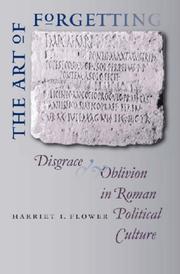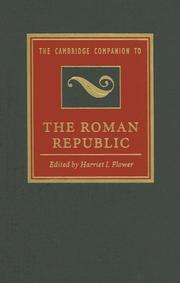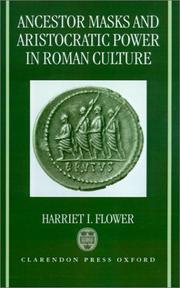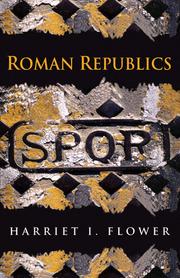| Listing 1 - 10 of 14 | << page >> |
Sort by
|

ISBN: 0807830631 9780807830635 0807871885 0807877468 9780807877463 9780807871881 9780807871881 9798893131239 Year: 2011 Volume: *5 Publisher: Chapel Hill University of North Carolina Press
Abstract | Keywords | Export | Availability | Bookmark
 Loading...
Loading...Choose an application
- Reference Manager
- EndNote
- RefWorks (Direct export to RefWorks)
Provides the chronological overview of the development of the Roman practice - an instruction to forget - from archaic times into the second century CE. This book explores Roman memory sanctions against the background of Greek and Hellenistic cultural influence and in the context of the wider Mediterranean world.
Memory --- Punishment --- Political aspects --- History. --- Social aspects --- Rome --- History
Book
ISBN: 1400888018 9781400888016 0691175004 9780691175003 Year: 2017 Publisher: Princeton : Princeton University,
Abstract | Keywords | Export | Availability | Bookmark
 Loading...
Loading...Choose an application
- Reference Manager
- EndNote
- RefWorks (Direct export to RefWorks)
The most pervasive gods in ancient Rome had no traditional mythology attached to them, nor was their worship organized by elites. Throughout the Roman world, neighborhood street corners, farm boundaries, and household hearths featured small shrines to the belovedlares, a pair of cheerful little dancing gods. These shrines were maintained primarily by ordinary Romans, and often by slaves and freedmen, for whom thelarescult provided a unique public leadership role. In this comprehensive and richly illustrated book, the first to focus on thelares, Harriet Flower offers a strikingly original account of these gods and a new way of understanding the lived experience of everyday Roman religion. Weaving together a wide range of evidence, Flower sets forth a new interpretation of the much-disputed nature of thelares. She makes the case that they are not spirits of the dead, as many have argued, but rather benevolent protectors-gods of place, especially the household and the neighborhood, and of travel. She examines the rituals honoring thelares, their cult sites, and their iconography, as well as the meaning of the snakes often depicted alongsidelaresin paintings of gardens. She also looks at Compitalia, a popular midwinter neighborhood festival in honor of thelares, and describes how its politics played a key role in Rome's increasing violence in the 60s and 50s BC, as well as in the efforts of Augustus to reach out to ordinary people living in the city's local neighborhoods. A reconsideration of seemingly humble gods that were central to the religious world of the Romans, this is also the first major account of the full range oflaresworship in the homes, neighborhoods, and temples of ancient Rome. Some images inside the book are unavailable due to digital copyright restrictions.
E-books --- Lares. --- Serpents --- Cults --- Religious aspects. --- Rome --- Religious life and customs. --- Religion. --- Cultes --- Aspect religieux --- Vie religieuse --- Religion --- Lares --- Serpents (Symbolism) --- Religious aspects --- Religious life and customs --- Rome (Italy) --- Serpents - Religious aspects --- Cults - Rome --- Rome (Italy) - Religion --- Rome (Italy) - Religious life and customs

ISBN: 0521003903 0521807948 9780521807944 9780521003902 9781139000338 Year: 2004 Publisher: Cambridge Cambridge University Press
Abstract | Keywords | Export | Availability | Bookmark
 Loading...
Loading...Choose an application
- Reference Manager
- EndNote
- RefWorks (Direct export to RefWorks)
Rome --- History --- Histoire --- Republic, 510-30 B.C. --- Rome - History - Republic, 510-30 B.C.

ISBN: 0198150180 9780198150183 Year: 1996 Publisher: Oxford: Clarendon,
Abstract | Keywords | Export | Availability | Bookmark
 Loading...
Loading...Choose an application
- Reference Manager
- EndNote
- RefWorks (Direct export to RefWorks)
Funerales --- Máscaras --- Poder (Ciencias sociales) --- Élite (Ciencias sociales) --- Ritos y ceremonias --- Roma --- Nobleza. --- --Rite funéraire --- --Religions antiques --- --Culte --- -Masks --- Elite (Social sciences) --- Funeral rites and ceremonies --- Masks --- Nobility --- Power (Social sciences) --- Empowerment (Social sciences) --- Political power --- Exchange theory (Sociology) --- Political science --- Social sciences --- Sociology --- Consensus (Social sciences) --- Costume --- Carnival --- Funeral rites and ceremonies, Roman --- Elites (Social sciences) --- Leadership --- Social classes --- Social groups --- Classes sociales --- --Élites --- --Rome ancienne --- --Rome --- --Funerales --- --Elite (Social sciences) --- Funeral rites and ceremonies - Rome --- Power (Social sciences) - Rome --- Masks - Rome --- Nobility - Rome --- Elite (Social sciences) - Rome --- Élites --- Rite funéraire --- Rome ancienne --- Religions antiques --- Culte --- Rome

ISBN: 9780691140438 069114043X 9780691152585 0691152586 1282303864 1400831164 9786612303869 Year: 2010 Publisher: Princeton: Princeton university press,
Abstract | Keywords | Export | Availability | Bookmark
 Loading...
Loading...Choose an application
- Reference Manager
- EndNote
- RefWorks (Direct export to RefWorks)
From the Renaissance to today, the idea that the Roman Republic lasted more than 450 years--persisting unbroken from the late sixth century to the mid-first century BC--has profoundly shaped how Roman history is understood, how the ultimate failure of Roman republicanism is explained, and how republicanism itself is defined. In Roman Republics, Harriet Flower argues for a completely new interpretation of republican chronology. Radically challenging the traditional picture of a single monolithic republic, she argues that there were multiple republics, each with its own clearly distinguishable strengths and weaknesses. While classicists have long recognized that the Roman Republic changed and evolved over time, Flower is the first to mount a serious argument against the idea of republican continuity that has been fundamental to modern historical study. By showing that the Romans created a series of republics, she reveals that there was much more change--and much less continuity--over the republican period than has previously been assumed. In clear and elegant prose, Roman Republics provides not only a reevaluation of one of the most important periods in western history but also a brief yet nuanced survey of Roman political life from archaic times to the end of the republican era.
937.02 --- History Ancient world Italy Period of Roman Republic 510-31 B.C. --- History Ancient world Italy Period of Roman Republic 510-31 B.C --- Rome --- History --- Politics and government --- Roman history --- Rome - Politics and government - 510-30 B.C. --- Rome - History - Republic, 510-30 B.C. --- Politique et gouvernement --- 510-30 av. J.-C. --- 509-30 av. J.-C. (République)
Book
ISBN: 1107032245 1107669421 9781107032248 9781107669420 9781139424783 Year: 2014 Publisher: Cambridge Cambridge University Press
Abstract | Keywords | Export | Availability | Bookmark
 Loading...
Loading...Choose an application
- Reference Manager
- EndNote
- RefWorks (Direct export to RefWorks)
Rome --- Römisches Reich. --- History --- Republic, 510-30 B.C.
Book
ISBN: 9781400831166 Year: 2011 Publisher: Princeton, NJ
Abstract | Keywords | Export | Availability | Bookmark
 Loading...
Loading...Choose an application
- Reference Manager
- EndNote
- RefWorks (Direct export to RefWorks)
Book
ISBN: 1139985450 1139990063 1139424785 9781139985451 9781139990066 9781139424783 9781107032248 9781107669420 Year: 2014 Publisher: Cambridge Cambridge University Press
Abstract | Keywords | Export | Availability | Bookmark
 Loading...
Loading...Choose an application
- Reference Manager
- EndNote
- RefWorks (Direct export to RefWorks)
The Cambridge Companion to the Roman Republic examines all aspects of Roman history and civilization from 509 to 49 BC. The key development of the republican period was Rome's rise from a small city to a wealthy metropolis, which served as the international capital of an extensive Mediterranean empire. These centuries produced a classic republican political culture, closely associated with the growth of a world empire. They also witnessed the slow disintegration of republican government under the relentless and combined pressure of external commitments, growing internal dissension, and the boundless ambition of successful military leaders. In the second edition of this Companion volume, distinguished European, Canadian, and American scholars present a variety of lively current approaches to understanding the political, military, and social aspects of Roman history, as well as its literary and visual culture. The second edition includes a new introduction, three new chapters on population, slavery, and the rise of empire, and updated bibliographies and maps.
Book
ISBN: 1139000330 Year: 2004 Publisher: Cambridge : Cambridge University Press,
Abstract | Keywords | Export | Availability | Bookmark
 Loading...
Loading...Choose an application
- Reference Manager
- EndNote
- RefWorks (Direct export to RefWorks)
The Cambridge Companion to the Roman Republic examines all aspects of Roman history and civilization from 509-49 BC. The key development of the republican period was Rome's rise from a small city to a wealthy metropolis and international capital of an extensive Mediterranean empire. These centuries produced the classic republican political system and the growth of a world empire. They also witnessed the disintegration of this system under the pressure of internal dissension and boundless ambition of its leading politicians. In this Companion volume, distinguished European and American scholars present a variety of lively approaches to understanding the political, military, and social aspects of Roman history, as well as its literary and visual culture. Designed to be accessible to the general reader and to students, The Cambridge Companion to the Roman Republic will invite further exploration to a vital, formative period of Roman history and its later influence.

ISBN: 9781400831166 9780691140438 Year: 2011 Publisher: Princeton, N.J. Princeton University Press
Abstract | Keywords | Export | Availability | Bookmark
 Loading...
Loading...Choose an application
- Reference Manager
- EndNote
- RefWorks (Direct export to RefWorks)
| Listing 1 - 10 of 14 | << page >> |
Sort by
|

 Search
Search Feedback
Feedback About UniCat
About UniCat  Help
Help News
News